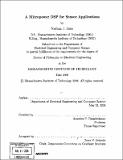A micropower DSP for sensor applications
Author(s)
Ickes, Nathan J. (Nathan Jeffrey), 1979-
DownloadFull printable version (45.79Mb)
Alternative title
Micropower digital signal processing for sensor applications
Other Contributors
Massachusetts Institute of Technology. Dept. of Electrical Engineering and Computer Science.
Advisor
Anantha P. Chandrakasan.
Terms of use
Metadata
Show full item recordAbstract
Ultra-low power systems, such as wireless microsensor networks or implanted medical devices, are driving the development of processors capable of performing increasingly complicated computations using mere microwatts of power. This thesis describes the design of a micropower DSP intended for medium bandwidth microsensor applications (such as acoustic sensing and tracking) which achieves 4 MIPS performance at 40 [mu]W (10 pJ per instruction) operating at 450 mV and fabricated in 90 nm CMOS. Energy efficiency optimizations include a custom CPU instruction set, a miniature instruction cache with a novel replacement strategy, hardware accelerator cores for FIR filter and FFT operations, and extensive power gating of both logic and memory. The tradeoffs of cache size, line length, and replacement policy for very small (a few hundred words or less) caches are explored, as are the design implications of optimizing the cache for minimum energy without regard to performance (since onchip memory access is already single-cycle). A replacement policy designed to reduce thrashing in miniature instruction caches is presented. Efficient control of power-gated circuits requires consideration of the minimum off time, or break-even time. An energy model for determining the break-even time is developed, which correlates with measurements of the power-gated domains on the DSP. The energy savings obtained from hardware accelerators for FIR filtering and FFT operations are measured, and a model is developed to predict the actual net power reduction in a real system, including factors such as sampling rate, leakage power, latency requirements, and power gating overhead.
Description
Thesis (Ph. D.)--Massachusetts Institute of Technology, Dept. of Electrical Engineering and Computer Science, 2008. Includes bibliographical references (p. 171-176).
Date issued
2008Department
Massachusetts Institute of Technology. Department of Electrical Engineering and Computer SciencePublisher
Massachusetts Institute of Technology
Keywords
Electrical Engineering and Computer Science.